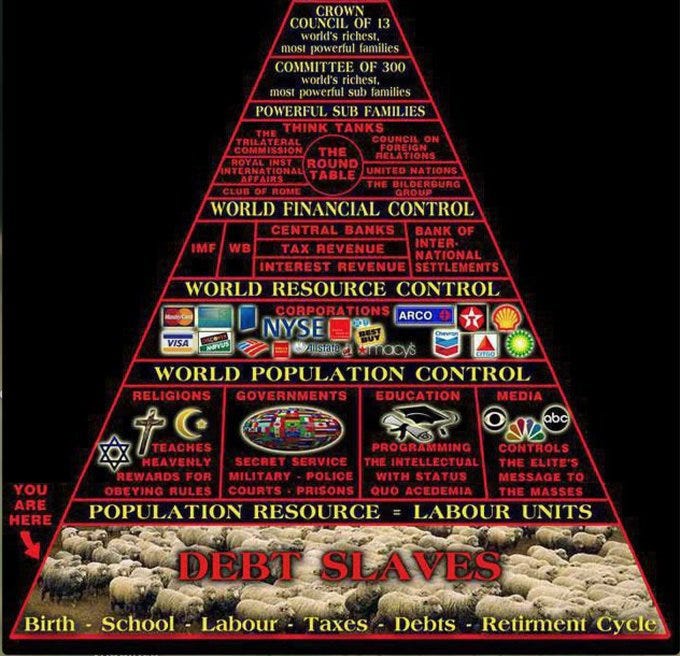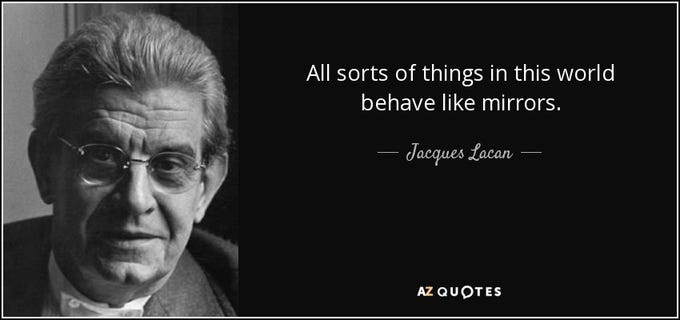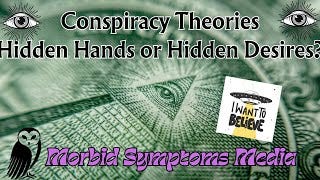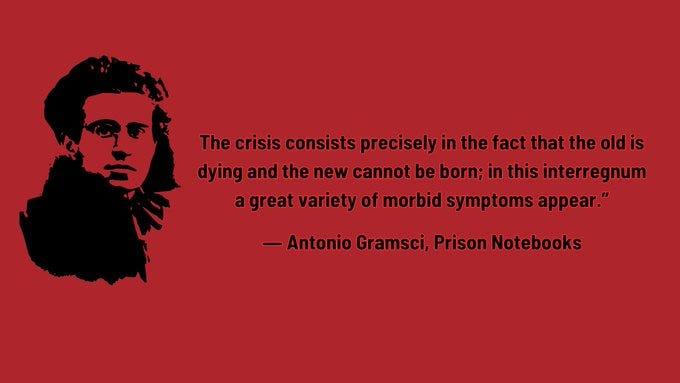Prologue
Jimmy Dore posted: "We’ve been lied to on a scale most people’s brains can’t comprehend."
I responded: "Today, if someone acts as if the government, its three-letter agencies, and their corporate or NGO flanks work for the public good, they're either complicit in the glorified protection racket or cynics who participate because 'what else can you do?' We know we're being gaslit, and the gaslighters know we know. Yet, most still prefer the 'blue pill' because stopping the pretense is terrifying, especially for those one paycheck away from destitution. And no political movement, yet, offers a vision and organizational discipline that instills hope or solidarity. In terms of the 5 stages of grief, 90 percent of us oscillate between denial, bargaining, anger and depression."
Someone responded with this Crown Council of 13 meme (below) which got me to thinking about how conspiracy theories affect our politics and our psychic or libidinal economy. This sparked a consideration of the psychological mechanisms at play in our attraction to such narratives and the historical contexts of these secret societies.
Introduction: The Comfort of Secret Societies
Conspiracy theories have long fascinated the public, offering thrilling narratives of hidden truths and secret societies manipulating world events. The idea that groups like the Illuminati, Freemasons, or the Council of 13 hold the reins of power provides a sense of understanding and control in an otherwise chaotic world.
But what if there is no hidden center? What if the tip of the iceberg is all there is? What if the belief in all powerful, but hidden, secret societies are largely manifestations of our collective anxieties and desires?
In this article, we will explore the historical contexts of these secret societies and apply psychoanalytic theories to understand why such conspiracy theories persist. We will delve into how Lacan's logic of the fantasy helps explain the allure of these narratives and consider the possibility that the visible tip might indeed be all there is. Additionally, we will discuss the process of "traversing the secret society fantasy" to understand how we can move beyond these comforting illusions.
Freemasons, Illuminati, and the Council of 13: A brief Overview
Freemasons
The Freemasons are one of the oldest fraternal organizations in the world, with origins tracing back to the medieval stonemasonry guilds. The history of Freemasonry can be divided into three phases:
Operative Freemasonry: In the Middle Ages, stonemasons formed guilds to regulate the qualifications of their members and their interactions with clients.
Transition to Speculative Freemasonry: As the need for operative stonemasons decreased, lodges began accepting honorary members who were not craftsmen, giving rise to speculative Freemasonry.
Modern Freemasonry: The establishment of the first Grand Lodge in London in 1717 marked the formalization of Freemasonry as we know it today, with a focus on moral and philosophical teachings rather than stonemasonry.
Freemasonry's rituals and symbols are steeped in allegory, with many tracing their origins to the construction of King Solomon's Temple and the legendary figure of Hiram Abiff, considered the first Freemason. The organization is structured around lodges, governed by regional or national Grand Lodges, and has a storied history intertwined with myths and speculative histories.
Illuminati
The Illuminati refers to several groups, both real and fictitious, historically the most notable being the Bavarian Illuminati. This secret society was founded on May 1, 1776, by Adam Weishaupt, a professor of canon law at the University of Ingolstadt. The goal of the Bavarian Illuminati was to promote Enlightenment ideals and curb the abuses of state power. Despite its short-lived existence (it was disbanded in 1785), the Illuminati has become a focal point in numerous conspiracy theories alleging it secretly controls world affairs.
These theories often suggest that the Illuminati has infiltrated governments and large organizations, manipulating global events to achieve a New World Order. Despite the lack of evidence supporting these claims, the idea of a hidden, powerful group pulling the strings behind the scenes has persisted in popular culture.
Council of 13
The Council of 13 is a term often used in conspiracy theories to describe an elite group of individuals believed to be at the top of a global power structure. This council is said to consist of influential families or leaders who secretly control major world events and institutions. Like the Illuminati, the existence of such a council lacks credible evidence and is largely a product of speculative and fictional narratives.
Conspiracy Theories and Lacan's Logic of the Fantasy
Jacques Lacan's logic of the fantasy provides a useful framework to understand how conspiracy theories like those involving the Freemasons, Illuminati, and the Council of 13 operate. In Lacanian theory:
- $ represents the Subject, the believer of the conspiracy theory
- a (objet petit a) is the unattainable object of desire that drives the narrative.
- <> symbolizes the mediating fantasy that structures the subject's interaction with the objet petit a.
Conspiracy theories function as fantasies that allow individuals to project their anxieties and desires onto a hidden object (secret societies).
This fantasy sustains their engagement by perpetually promising revelation without ever fully delivering it. The process of seeking the hidden truth becomes the object of desire itself, ensuring that believers remain invested in the conspiracy narrative.
Ideological Fantasies and Defense Mechanisms
It is important to note that analyzing conspiracy theories as ideological fantasies does not dismiss the potential grains of truth within them. Freemasons do exist, and the wealthiest families in the world do wield considerable influence, likely rub elbows with each other, and have shared class interests. These realities can give rise to perceptions and narratives that exaggerate or misinterpret their power.
From a psychoanalytic perspective, these conspiracy theories function as ideological fantasies and defense mechanisms against "the Real"—the aspects of our world that are too complex, chaotic, or unsettling to confront directly. By providing a structured narrative with identifiable villains and heroes, conspiracy theories offer a semblance of control and understanding, shielding individuals from the anxiety of the unknown and radical freedom.
Moreover, many people find comfort in believing that a hidden group is in control rather than accepting the reality that no single group or entity is in charge. This absence of a "big Other" or "subject supposed to know/control" can be deeply unsettling. The notion that the world is arbritary or random, without a central controlling force, can provoke existential anxiety. Conspiracy theories, therefore, serve as a defense mechanism, providing a false sense of order and control.
Traversing Ideological Fantasies
Letting go of ideological fantasies, particularly those embodied in conspiracy theories, involves a psychoanalytic process that helps individuals confront and move beyond the comforting illusions that sustain their beliefs. This process can be understood through the lens of Lacanian psychoanalysis, especially the concepts of "going through the fantasy" and "dissolution of transference." Here’s how these fantasies can be traversed:
1. Recognizing the Fantasy Structure
The first step is to recognize that conspiracy theories function as fantasies that provide a structured narrative to cope with 'the Real' of reality. Jacques Lacan's matheme of the fantasy $ <> a highlights how these narratives are constructed around an unattainable object of desire (objet petit a) that drives the believer’s engagement.
2. Identifying the Objet Petit a
Understanding the specific object of desire that sustains the conspiracy theory is crucial. This could be the hidden "truth" or secret knowledge that believers are seeking. Recognizing that this object is a construct that perpetuates the fantasy can help individuals see through the illusion.
3. Going Through the Fantasy
Lacan's concept of "going through the fantasy" involves confronting the underlying desires and anxieties that the fantasy addresses. This means understanding how the fantasy functions as a defense mechanism against "the Real" — the aspects of reality that are too unsettling to face directly.
4. Dissolution of Transference
Transference is the process by which individuals project their desires and anxieties onto an external figure or narrative. In the context of conspiracy theories, this might involve projecting fears of powerlessness onto a perceived omnipotent secret group. Dissolving transference involves recognizing these projections and reclaiming personal agency.
5. Confronting "The Real"
Finally, confronting "the Real" means accepting the complexity, randomness, and uncertainty of the world. This involves moving away from the need for a simplistic, structured narrative and embracing the inherent uncertainties of life.
Conclusion
Understanding the historical context and psychological mechanisms behind groups like the Freemasons, Illuminati, and the Council of 13 can help demystify the allure of conspiracy theories. These narratives often fulfill deep-seated needs for control, understanding, and social cohesion. By recognizing these dynamics, we can better address the real issues at hand and avoid getting caught up in unfounded conspiracies.
By incorporating Lacan's matheme of the fantasy, we can further understand how conspiracy theories sustain themselves through the structure of desire and fantasy. The hidden secret (objet petit a) becomes the perpetually unattainable object that drives the believer's engagement with the fantasy, obscuring how the tip of the iceberg might indeed be all there is.
As we navigate this seemingly unending interregnum, it’s crucial to critically evaluate the information we encounter and consider the possibility that the visible might indeed be all there is. By doing so, we can avoid being trapped in the shadows of unfounded conspiracies and focus on understanding and addressing the pressing issues at hand.
Traversing ideological fantasies involves recognizing their structure, identifying the desires they fulfill, and confronting the unsettling realities they mask. This also fosters a more grounded and nuanced understanding of how the political and libidinal economies interact.
Podcast: Hidden Hands & Plans or Fears & Desires
Rumble X/Twitter YouTube
Like, Follow, Share and Subscribe to our other platforms










